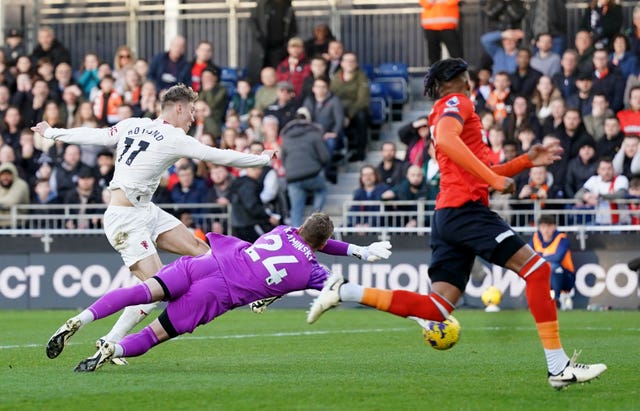Rasmus Hojlund’s goals against Luton on Sunday made him the youngest player ever to score in six consecutive Premier League games.
The 21-year-old Manchester United striker broke Joe Willock’s record and here, the PA news agency puts his achievement in context.
Six of the best

Hojlund’s scoring run began with the winner against Aston Villa on Boxing Day. That was his first-ever Premier League goal, having failed to score in his first 14 appearances, but he has not let up since.
He opened the scoring after three minutes in a 2-2 draw with Tottenham, netted against Wolves, West Ham and in the return fixture with Villa and then scored twice in the first seven minutes in the win over Luton.
Aged 21 years and 14 days, he is 260 days younger than Willock when he netted for Newcastle against Sheffield United in May 2021 to break the record previously held by Romelu Lukaku.
Willock extended his streak to seven games three days later against Fulham, who will also be United’s opponents on Saturday as Hojlund has the chance to break that record.
The Dane also has Manchester United’s longest scoring run since Cristiano Ronaldo’s first spell at the club. Marcus Rashford managed five in a row in January and February 2023 but Hojlund is the first United player to score in six consecutive league games since Ronaldo in 2008.
Willock’s run, while on loan from Arsenal, earned him a permanent move to Tyneside – but in a warning that nothing can be taken for granted, he has scored only five Premier League goals in 67 games since.
In good company

The list of the youngest players to achieve each goalscoring streak in the Premier League sees Hojlund join a high-profile group of names.
The early entries are players whose goalscoring impact came at a young age – James Vaughan and Danny Cadamarteri failed to build on their early promise with Everton while James Milner, who scored in back-to-back Leeds games as a 16-year-old, has had a long and successful top-flight career but rarely as a prolific marksman.
Beyond Cadamarteri’s three-game scoring run, the other names on the list are some of the league’s elite strikers – starting with Robbie Fowler, who scored in four straight games for Liverpool as a 19-year-old.
Nicolas Anelka scored in a fifth successive game for Arsenal in 1998 aged 19 years and 239 days, with an age gap of more than a year to Hojlund.
Willock still has the seven-game record, while Daniel Sturridge netted in eight in a row for Liverpool in 2014 aged 24.
No player has had a scoring streak of exactly nine games, meaning Ruud van Nistelrooy holds that record as well as the 10-game mark aged 27, while Jamie Vardy was 28 when he set the league’s record scoring run of 11 games for Leicester in their 2015-16 title-winning season.
